Fe-Al Phosphate Microcrystals in Pedogenic Goethite Pisoliths
Abstract
1. Introduction
2. Materials and Methods
2.1. Characterization of Materials
2.2. Geochemical Analyses
2.3. X-Ray Diffraction
2.4. Scanning Electron Microscopy and Elemental Analysis
3. Results
3.1. Mineralogy and Geochemistry of the Pedogenic Pisoliths
3.1.1. XRD Analysis
3.1.2. The Specific Surface Area (SSA) Estimation
3.1.3. XRF Analysis
3.2. SEM-EDX Analysis
3.2.1. Goethite Pisoliths and Nodules
3.2.2. Phosphate Minerals
4. Discussion
5. Conclusions
Supplementary Materials
Author Contributions
Funding
Acknowledgments
Conflicts of Interest
References
- Nriagu, J.O. Phosphate Minerals: Their Properties and General Modes of Occurrence. In Phosphate Minerals; Nriagu, J.O., Moore, P.B., Eds.; Springer: Berlin/Heidelberg, Germany, 1984; pp. 1–136. [Google Scholar]
- Moore, P.B.; Shen, J. An X-ray structural study of cacoxenite, a mineral phosphate. Nature 1983, 306, 356–358. [Google Scholar] [CrossRef]
- Anthony, J.W.; Bideaux, R.A.; Bladh, K.W.; Nichols, M.C. Handbook of Mineralogy, Volume IV. Arsenates, Phosphates, Vanadates, 1st ed.; Mineral Data Publishing: Tucson, AZ, USA, 2000; p. 88. [Google Scholar]
- Dill, H.G.; Weber, B.; Kaufhold, S. The origin of siderite-goethite-phosphate mineralization in the karst-related faultbound iron ore deposit Auerbach, Germany, a clue to the timing of hypogene and supergene Fe-Al phosphates in NE Bavaria. Neues Jahrb. Mineral. Abh. 2009, 186, 283–307. [Google Scholar] [CrossRef]
- Mills, S.J. A note on perhamite from the Moculta (Klemms) phosphate quarry, South Australia. Aust. J. Miner. 2003, 9, 43–45. [Google Scholar]
- Hearn, P.P.J.; Mccartan, L.; Soller, D.R.; Krohn, M.D.; Gonzalez, V.M. Cacoxenite in Miocene Sediments of the Maryland Coastal Plain. Clays Clay Miner. 1988, 36, 419–424. [Google Scholar] [CrossRef]
- Steinmann, J. Kákoxèn. Archiv. Für. Die Gesammte Nat. 1826, 8, 446. [Google Scholar]
- Nunes, A.P.L.; Peres, A.E.C.; Araujo, A.C.; Valadao, G.E.S. Electrokinetic properties of wavellite and its floatability with cationic and anionic collectors. J. Colloid Interface Sci. 2011, 361, 632–638. [Google Scholar] [CrossRef]
- Huminicki, D.M.C.; Hawthorne, F.C. The Crystal Chemistry of the Phosphate Minerals. Rev. Mineral. Geochem. 2002, 48, 123–253. [Google Scholar] [CrossRef]
- Bayliss, P.; Kolitsch, U.; Nickel, E.H.; Pring, A. Alunite supergroup: Recommended nomenclature. Mineral. Mag. 2010, 74, 919–927. [Google Scholar] [CrossRef]
- Blount, A.M. The crystal structure of crandallite. Am. Miner. 1974, 59, 41–47. [Google Scholar]
- Tiessen, H.; Stewart, J.W.B.; Cole, C.V. Pathways of Phosphorus Transformations in Soils of Differing Pedogenesis. Soil Sci. Soc. Am. J. 1984, 48, 853–858. [Google Scholar] [CrossRef]
- Schwertmann, U.; Schieck, E. Das Verhalten von Phosphat in eisenoxidreichen Kalkgleyen der Münchnener Schotterebene. Z. Pflanz. Bodenkund. 1980, 143, 391–401. [Google Scholar] [CrossRef]
- Tiessen, H.; Lo Monaco, S.; Ramirez, A.; Santos, M.C.D.; Shang, C. Phosphate minerals in a lateritic crust from Venezuela. Biogeochemistry 1996, 34, 1–17. [Google Scholar] [CrossRef]
- Antelo, J.; Arce, F.; Avena, M.; Fiol, S.; López, R.; Macías, F. Adsorption of a soil humic acid at the surface of goethite and its competitive interaction with phosphate. Geoderma 2007, 138, 12–19. [Google Scholar] [CrossRef]
- Fink, J.R.; Inda, A.V.; Bavaresco, J.; Barrón, V.; Torrent, J.; Bayer, C. Adsorption and desorption of phosphorus in subtropical soils as affected by management system and mineralogy. Soil Tillage Res. 2016, 155, 62–68. [Google Scholar] [CrossRef]
- Bardossy, G.; Aleva, G.J.J. Lateritic Bauxites–Developments in Economic Geology 27; Elsevier: Amsterdam, The Netherlands, 1990; pp. 1–624. [Google Scholar]
- Boulange, B.; Ambrosi, J.P.; Nahon, D. Laterites and Bauxites. In Soils and Sediments; Paquet, H., Clauer, N., Eds.; Springer: Berlin/Heidelberg, Germany, 1997; pp. 49–65. [Google Scholar]
- Dill, H.G.; Melcher, F.; Gerdes, A.; Weber, B. The origin and zoning of hypogene and supergene Fe-Mn-Mg-Sc-UREE-Zn phosphate mineralization from the newly discovered Trutzhofmühle aplite (Hagendorf pegmatite province, Germany). Can. Mineral. 2008, 46, 1131–1157. [Google Scholar] [CrossRef]
- Kämpf, N.; Schwertmann, U. The 5M-NaOH concentration treatment for iron oxides in soils. Clays Clay Miner. 1982, 30, 401–408. [Google Scholar] [CrossRef]
- Schaefer, C.; Fabris, J.; Ker, J. Minerals in the clay fraction of Brazilian Latosols (Oxisols): A review. Clay Miner. 2008, 43, 137–154. [Google Scholar] [CrossRef]
- Carvalho Filho, A.; Inda, A.V.; Fink, J.R.; Curi, N. Iron oxides in soils of different lithological origins in Ferriferous Quadrilateral (Minas Gerais, Brazil). Appl. Clay Sci. 2015, 118, 1–7. [Google Scholar] [CrossRef]
- Fink, J.R.; Inda, A.V.; Tiecher, T.; Barrón, V. Iron oxides and organic matter on soil phosphorus availability. Ciênc. Agrotec. 2016, 40, 369–379. [Google Scholar] [CrossRef]
- Cornell, R.M.; Schwertmann, U. The Iron Oxides; VCH Verlag: Weinheim, Germany, 2003; pp. 1–664. [Google Scholar]
- Guzman, G.; Alcantara, E.; Barrón, V.; Torrent, J. Phytoavailability of phosphate adsorbed on ferrihydrite, hematite, and goethite. Plant Soil 1994, 159, 219–225. [Google Scholar] [CrossRef]
- Adeleye, D.R. Origin of ironstones, an example from the middle Niger Valley, Nigeria. J. Sed. Petrol. 1973, 43, 709–723. [Google Scholar]
- Glassford, D.K.; Semeniuk, V. Desert-aeolian origin of late Cenozoic regolith in arid and semi-arid Southwestern Australia. Palaeogeogr. Palaeoclim. Palaeoecol. 1995, 114, 131–166. [Google Scholar] [CrossRef]
- Anand, R.R.; Paine, M. Regolith geology of the Yilgarn Craton, Western Australia: Implications for exploration. Aust. J. Earth Sci. 2002, 49, 3–162. [Google Scholar] [CrossRef]
- Lascelles, D.F. The origin of terrestrial pisoliths and pisolitic iron ore deposits: Raindrops and sheetwash in a semi-arid environment. Sed. Geol. 2016, 341, 232–244. [Google Scholar] [CrossRef]
- Maciąg, Ł.; Rydzewska, U.; Skowronek, A.; Salwa, S. Mineralogy and Geochemistry of Fluvial-Lacustrine Pisolith Micronodules from the Roztoka Odrzańska, Odra River, NW Poland. Geosciences 2019, 10, 3. [Google Scholar] [CrossRef]
- Clarke, J.D.A.; Chenoweth, L. Classification, genesis and evolution of ferruginous surface grains. AGSO J. Aust. Geol. Geophys. 1996, 16, 213–221. [Google Scholar]
- Bourman, R.P. Modes of ferricrete genesis–evidence from southeastern Australia. Z. Geomorph. 1993, 37, 77–101. [Google Scholar]
- Schulz, M.S.; Vivit, D.; Schulz, C.; Fitzpatrick, J.; White, A. Biologic Origin of Iron Nodules in a Marine Terrace Chronosequence, Santa Cruz, California. Soil Sci. Soc. Am. J. 2010, 74, 550–564. [Google Scholar] [CrossRef]
- Löhr, S.C.; Grigorescu, M.; Cox, M.E. Iron nodules in ferric soils of the Fraser Coast, Australia: Relicts of laterisation or features of contemporary weathering and pedogenesis? Soil Res. 2013, 51, 77–93. [Google Scholar] [CrossRef]
- Kovács, J.; Fábián, S.A.; Varga, G.; Újvári, G.; Varga, G.; Dezső, J. Plio-Pleistocene red clay deposits in the Pannonian basin: A review. Quat. Int. 2011, 240, 35–43. [Google Scholar] [CrossRef]
- Kovács, J.; Raucsik, B.; Varga, A.; Újvári, G.; Varga, G.; Ottner, F. Clay mineralogy of red clay deposits from the central Carpathian Basin (Hungary): Implications for Plio-Pleistocene chemical weathering and palaeoclimate. Turk. J. Earth Sci. 2013, 22, 414–426. [Google Scholar]
- Feret, F.R. Mining: Mineral ores and products. In Industrial Applications of X-ray Diffraction; Chung, F.H., Smith, D.K., Eds.; Marcel Dekker, Inc.: New York, NY, USA; Basel, Switzerland, 2000; pp. 385–414. [Google Scholar]
- Ritchie, N.; Newbury, D.; Davis, J. EDS Measurements of X-Ray Intensity at WDS Precision and Accuracy Using a Silicon Drift Detector. Microsc. Microanal. 2012, 18, 892–904. [Google Scholar] [CrossRef] [PubMed]
- Salge, T.; Neumann, R.; Andersson, C.; Patzschke, M. Advanced mineral classification using feature analysis and spectrum imaging with EDS. In 23rd International Mining Congress and Exhibition of Turkey (IMCET 2013); Bengu, I., Gulsun, M., Eds.; Chamber of Mining Engineers of Turkey: Ankara, Turkey, 2013; pp. 357–367. [Google Scholar]
- Schulz, B.; Merker, G.; Gutzmer, J. Automated SEM Mineral Liberation Analysis (MLA) with Generically Labelled EDX Spectra in the Mineral Processing of Rare Earth Element Ores. Minerals 2019, 9, 527. [Google Scholar] [CrossRef]
- Rumble, J. CRC Handbook of Chemistry and Physics; Taylor & Francis Ltd.: Boca Raton, FA, USA, 2019; pp. 1–1532. [Google Scholar]
- Kovács, J.; Varga, G.; Dezső, J. Comparative study on the Late Cenozoic red clay sediments from China and Central Europe (Hungary). Geol. Quart. 2008, 52, 369–382. [Google Scholar]
- Tardy, Y. Petrology of Laterites and Tropical Soils; A.A. Balkema Publishers: Rotterdam, The Netherlands, 1997; pp. 1–419. [Google Scholar]
- Gebru, Y.; Elueze, A.A.; Amare, K.; Dongmo, F.W.N. Compositional characteristics and genetic affinity of the ferricrete deposit in Adi Kokeb district, northwestern Tigray, Ethiopia. Appl. Earth Sci. 2019, 128, 146–157. [Google Scholar] [CrossRef]
- Bortoluzzi, E.C.; Pérez, C.A.S.; Ardisson, J.D.; Tiecher, T.; Caner, L. Occurrence of iron and aluminum sesquioxides and their implications for the P sorption in subtropical soils. Appl. Clay Sci. 2015, 104, 196–204. [Google Scholar] [CrossRef]
- Wang, X.; Liu, F.; Tan, W.; Li, W.; Feng, X.; Sparks, D.L. Characteristics of Phosphate Adsorption-Desorption Onto Ferrihydrite: Comparison With Well-Crystalline Fe (Hydr)Oxides. Soil Sci. 2013, 178, 1–11. [Google Scholar] [CrossRef]
- Wei, S.; Tan, W.; Liu, F.; Zhao, W.; Weng, L. Surface properties and phosphate adsorption of binary systems containing goethite and kaolinite. Geoderma 2014, 213, 478–484. [Google Scholar] [CrossRef]
- Driscoll, C.T.; Schecher, W.D. The chemistry of aluminum in the environment. Environ. Geochem. Health 1990, 12, 28–49. [Google Scholar] [CrossRef]
- Kampf, A.R.; Adams, P.M.; Barwood, H.; Nash, B.P. Fluorwavellite, Al3(PO4)2(OH)2F·5H2O, the fluorine analog of wavellite. Am. Mineral. 2017, 102, 909–915. [Google Scholar] [CrossRef]
- Flicoteaux, R.; Lucas, J. Weathering of phosphate minerals. In Phosphate Minerals; Nriagu, J.O., Moore, P.B., Eds.; Springer: Berlin/Heidelberg, Germany, 1984; pp. 292–317. [Google Scholar]
- Gnandi, K.; Tobschall, H.J. Distribution patterns of rare-earth elements and uranium in tertiary sedimentary phosphorites of Hahotoé–Kpogamé, Togo. J. Afr. Earth Sci. 2003, 37, 1–10. [Google Scholar] [CrossRef]
- Dill, H.G. The geology of aluminium phosphates and sulphates of the alunite group minerals: A review. Earth-Sci. Rev. 2001, 53, 35–93. [Google Scholar] [CrossRef]
- Nriagu, J.O. Phosphate–clay mineral relations in soils and sediments. Can. J. Earth Sci. 1976, 13, 717–736. [Google Scholar] [CrossRef]
- Salama, W. Paleoenvironmental significance of aluminum phosphate-sulfate minerals in the upper Cretaceous ooidal ironstones, E-NE Aswan area, southern Egypt. Int. J. Earth Sci. 2014, 103, 1621–1639. [Google Scholar]
- Goldberg, S.; Sposito, G. A chemical model of phosphate adsorption by soils. II. Noncalcareous soils. Soil Sci. Soc. Am. J. 1984, 48, 779–783. [Google Scholar]
- Huang, W.H.; Keller, W.D. Geochemical mechanics for the dissolution, transport, and deposition of aluminum in the zone of weathering. Clays Clay Miner. 1972, 20, 69–74. [Google Scholar]
- Vieillard, P.; Tardy, Y.; Nahon, D. Stability fields of clays and aluminum phosphates; parageneses in lateritic weathering of argillaceous phosphatic sediments. Am. Mineral. 1979, 64, 626–634. [Google Scholar]
- Nickel, E. Experimental dissolution of light and heavy minerals in comparison with weathering and intrastratal solution. Contrib. Sediment. 1973, 1, 1–68. [Google Scholar]
- Wang, L.; Putnis, C.V.; Ruiz-Agudo, E.; Hövelmann, J.; Putnis, A. In situ Imaging of Interfacial Precipitation of Phosphate on Goethite. Environ. Sci. Technol. 2015, 49, 4184–4192. [Google Scholar] [CrossRef]
- Wang, L.; Putnis, C.V.; Hövelmann, J.; Putnis, A. Interfacial Precipitation of Phosphate on Hematite and Goethite. Minerals 2018, 8, 207. [Google Scholar] [CrossRef]
- Gao, Y.; Mucci, A. Acid base reactions, phosphate and arsenate complexation, and their competitive adsorption at the surface of goethite in 0.7 M NaCl solution. Geochim. Cosmochim. Acta. 2001, 65, 2361–2378. [Google Scholar] [CrossRef]
- Freese, D.; Lookman, R.; Merckx, R.; van Riemsdijk, W.H. New Method for Assessment of Long-Term Phosphate Desorption from Soils. Soil Sci. Soc. Am. J. 1995, 59, 1295–1300. [Google Scholar] [CrossRef]
- Gustafsson, J.P. Modelling competitive anion adsorption on oxide minerals and an allophane-containing soil. Eur. J. Soil Sci. 2001, 52, 639–653. [Google Scholar] [CrossRef]

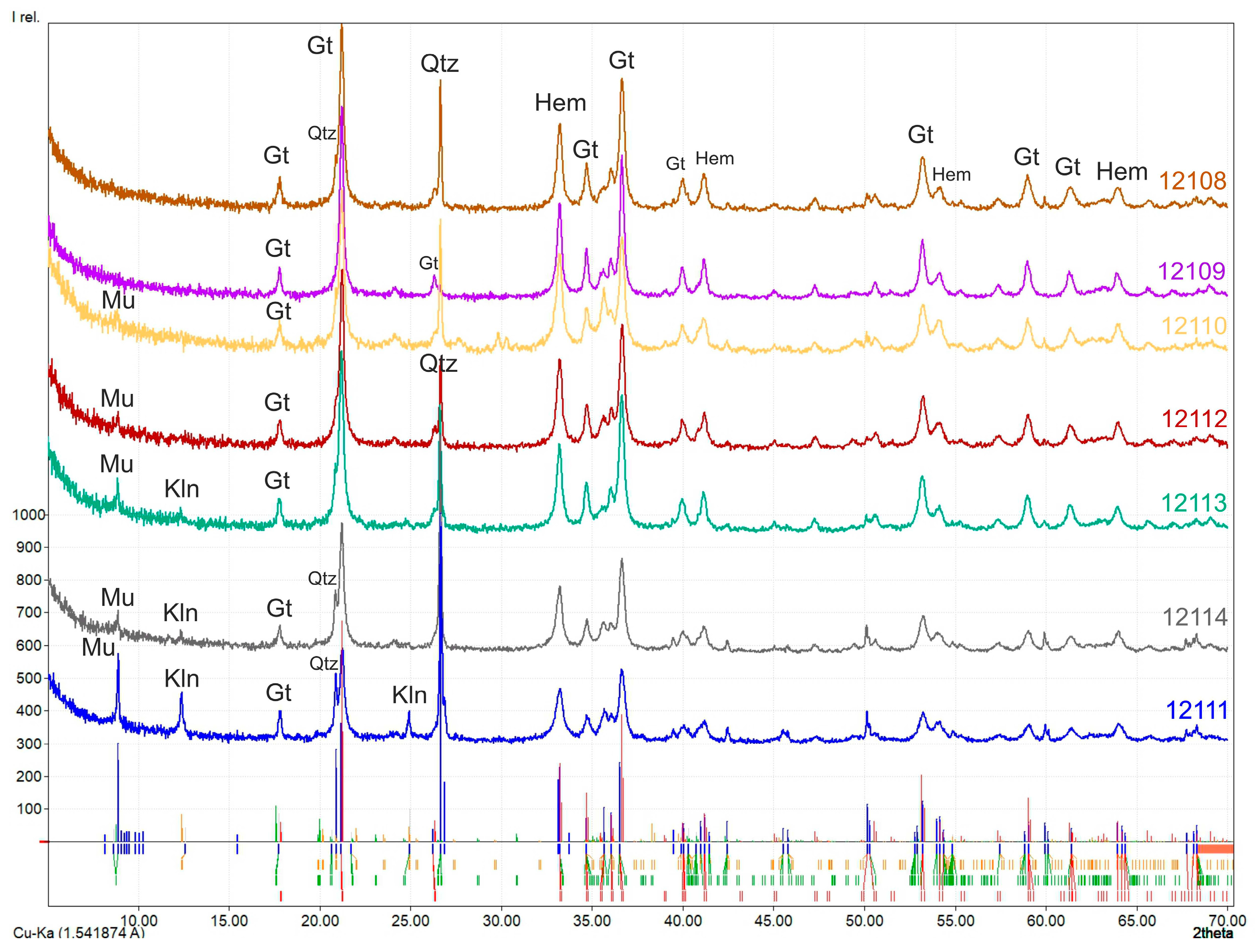
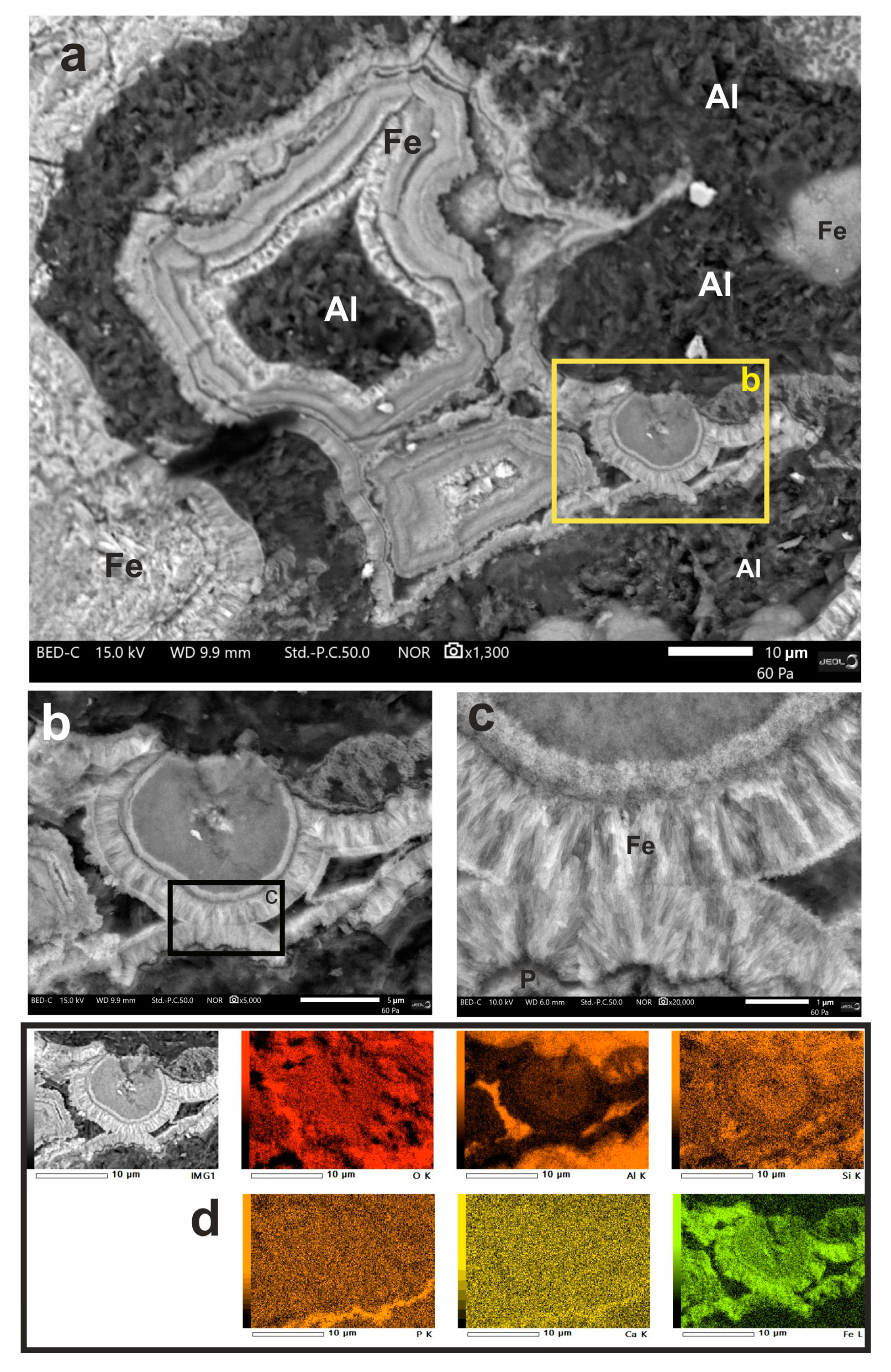
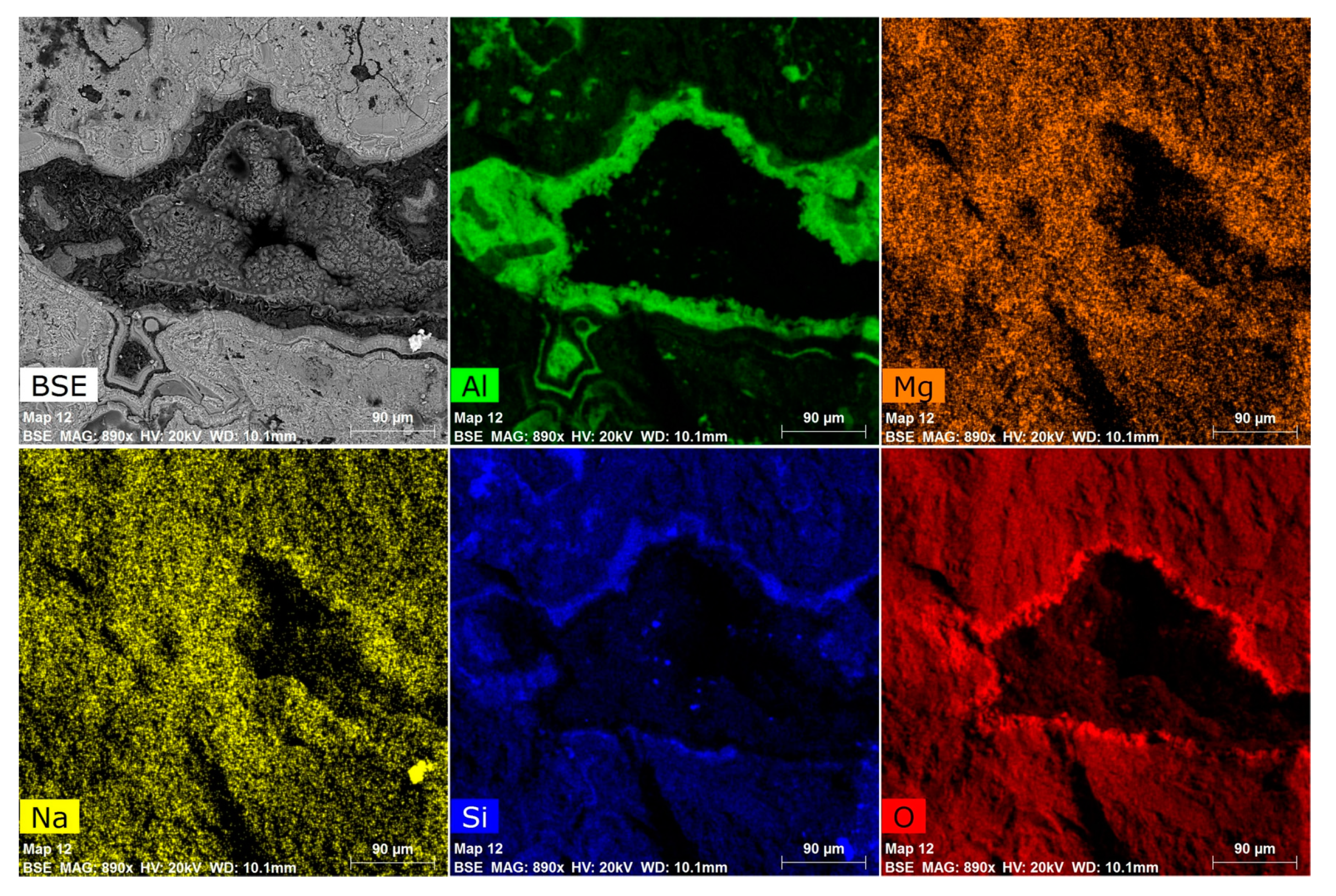
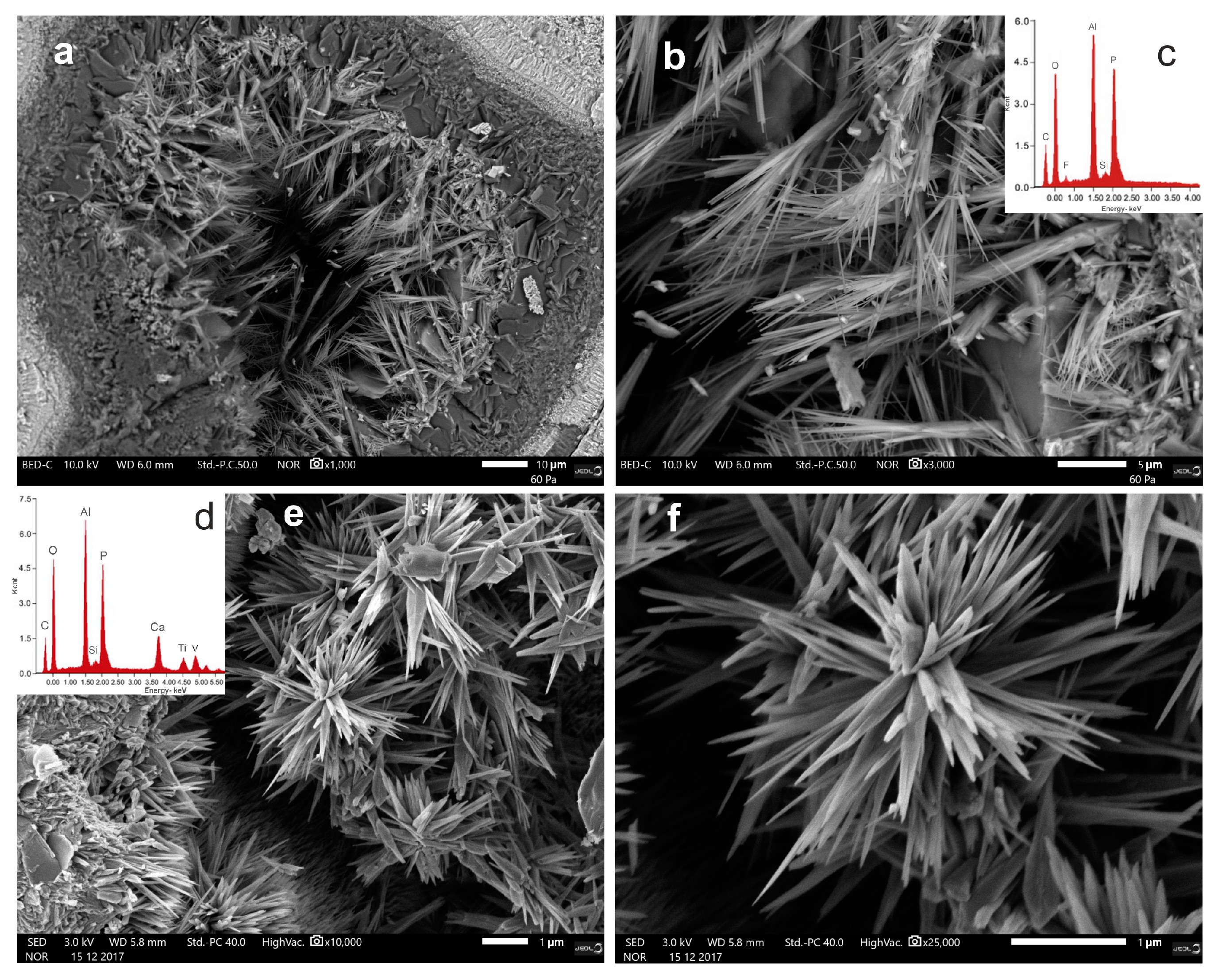
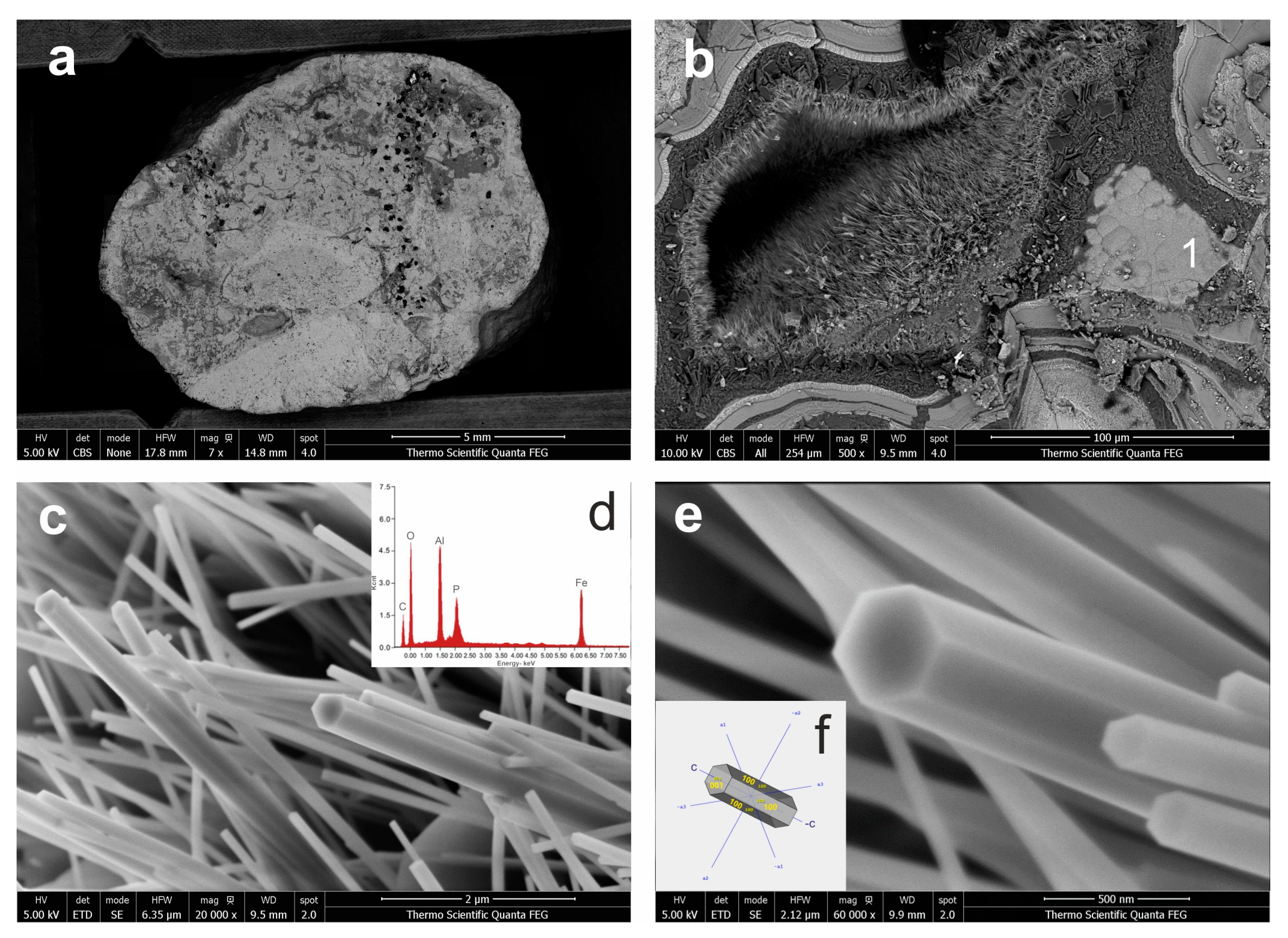
| Sample | Goethite (%) | Hematite (%) | Quartz (%) |
|---|---|---|---|
| 12108 | 80.9 | 5.0 | 5.0 |
| 12109 | 82.6 | 7.5 | 0.5 |
| 12110 | 74.6 | 12.0 | 5.0 |
| 12111 | 55.7 | 7.0 | 13.0 |
| 12112 | 79.1 | 8.0 | 4.0 |
| 12113 | 77.3 | 5.0 | 5.0 |
| 12114 | 69.2 | 8.0 | 12.0 |
| Mineral | Crystallite size (nm) | Density (g·cm−3) | SSA (m2·g−1) |
|---|---|---|---|
| Goethite | 49 | 4.28 | 28.60 |
| Hematite | 49 | 5.26 | 23.27 |
| Sample | SiO2 | Al2O3 | Fe2O3 | TiO2 | CaO | MgO | MnO | K2O | Na2O | P2O5 | LOI ** |
|---|---|---|---|---|---|---|---|---|---|---|---|
| 12108 | 24.0 | 5.30 | 57.1 | 0.190 | 0.32 | 0.72 | 0.101 | 0.86 | 0.470 | 1.560 | 8.71 |
| 12109 | 6.0 | 1.48 | 80.3 | 0.111 | 0.26 | 0.58 | 0.037 | 0.32 | 0.015 | 1.071 | 9.10 |
| 12110 | 20.4 | 4.45 | 62.9 | 0.170 | 0.42 | 0.55 | 0.150 | 0.71 | 0.470 | 1.130 | 8.21 |
| 12111 | 24.2 | 5.40 | 57.5 | 0.230 | 0.68 | 0.95 | 0.072 | 0.89 | 0.440 | 1.170 | 8.07 |
| 12112 | 8.6 | 3.02 | 76.2 | 0.127 | 0.15 | 0.42 | 0.050 | 0.26 | 0.009 | 1.220 | 9.60 |
| 12113 | 17.3 | 4.05 | 65.0 | 0.200 | 0.79 | 0.39 | 0.043 | 0.75 | 0.170 | 1.460 | 9.99 |
| 12114 | 9.7 | 2.28 | 75.0 | 0.127 | 0.64 | 0.49 | 0.250 | 0.40 | 0.074 | 1.260 | 9.10 |
| Average paleosols * | 56.5 | 18.6 | 6.95 | 0.89 | 1.45 | 2.45 | 0.1 | 2.35 | 0.45 | 0.11 | 10.6 |
© 2020 by the authors. Licensee MDPI, Basel, Switzerland. This article is an open access article distributed under the terms and conditions of the Creative Commons Attribution (CC BY) license (http://creativecommons.org/licenses/by/4.0/).
Share and Cite
Kovács, J.; Farics, É.; Szabó, P.; Sajó, I. Fe-Al Phosphate Microcrystals in Pedogenic Goethite Pisoliths. Minerals 2020, 10, 357. https://doi.org/10.3390/min10040357
Kovács J, Farics É, Szabó P, Sajó I. Fe-Al Phosphate Microcrystals in Pedogenic Goethite Pisoliths. Minerals. 2020; 10(4):357. https://doi.org/10.3390/min10040357
Chicago/Turabian StyleKovács, János, Éva Farics, Péter Szabó, and István Sajó. 2020. "Fe-Al Phosphate Microcrystals in Pedogenic Goethite Pisoliths" Minerals 10, no. 4: 357. https://doi.org/10.3390/min10040357
APA StyleKovács, J., Farics, É., Szabó, P., & Sajó, I. (2020). Fe-Al Phosphate Microcrystals in Pedogenic Goethite Pisoliths. Minerals, 10(4), 357. https://doi.org/10.3390/min10040357






